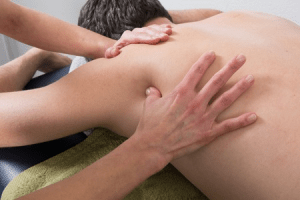
Frozen shoulder, also known as adhesive capsulitis, is a condition that causes pain and stiffness in the shoulder joint. It is a common condition, affecting about 2% of people at some point in their lives.
The exact cause of frozen shoulder is unknown, but it is thought to be due to a combination of factors, including:
- Inflammation of the shoulder joint capsule
- Reduced blood flow to the shoulder joint
- Changes in the collagen fibers in the shoulder joint capsule
- Muscle imbalances in the shoulder girdle

Frozen shoulder typically progresses through three stages:
- Freezing stage: This stage is characterized by pain and stiffness in the shoulder joint. The pain is usually worse at night and when the shoulder is used. The range of motion in the shoulder joint is gradually reduced.
- Frozen stage: This stage is characterized by severe pain and stiffness in the shoulder joint. The range of motion in the shoulder joint is severely limited. It may be difficult or impossible to raise the arm overhead or behind the back.
- hawing stage: This stage is characterized by gradual improvement in pain and stiffness. The range of motion in the shoulder joint gradually improves. It may take 12-18 months for the shoulder joint to fully recover.
Risk factors for frozen shoulder include:
- Age: Frozen shoulder is more common in people over the age of 40.
- Gender: Frozen shoulder is more common in women than men.
- Medical conditions: Frozen shoulder is more common in people with diabetes, thyroid problems, and heart disease.
- Injury: Frozen shoulder can develop after an injury to the shoulder joint.
- Surgery: Frozen shoulder can develop after surgery on the shoulder joint.
- Immobilization: Frozen shoulder can develop after a period of immobilization of the shoulder joint, such as after a cast or sling.

What Myotherapy can do in the treatment sessions for frozen shoulder?
Myotherapy is a type of massage therapy that can be helpful for frozen shoulder. Myotherapists use a variety of techniques to improve range of motion, reduce pain, and break up scar tissue in the shoulder joint.
Here are some of the myotherapy techniques that can be used to treat frozen shoulder:
- Myofascial release: Myofascial release is a technique that is used to release tension in the fascia, which is the connective tissue that surrounds muscles and organs.
- Trigger point therapy: Trigger point therapy is a technique that is used to apply pressure to specific points in muscles that are causing pain.
- Dry needling: Dry needling is a technique that involves inserting thin needles into specific points in the muscles. This can help to release trigger points and improve range of motion.
- Cupping: Cups may be glided around the shoulder joint, back, and neck. This can help to improve circulation, reduce inflammation, and relieve pain.


Cupping and dry needling are safe and effective treatments for frozen shoulder. They can help to improve range of motion, reduce pain, and speed up recovery. If you are experiencing symptoms of frozen shoulder, it is important to see a myotherapist or other healthcare professional for diagnosis and treatment.
- Stretching: Stretching can be used to improve range of motion in the shoulder joint.
- Joint mobilization: Joint mobilization is a technique that is used to gently move the shoulder joint through its range of motion.
Click on this link to book an appointment with one of our myotherapists.


